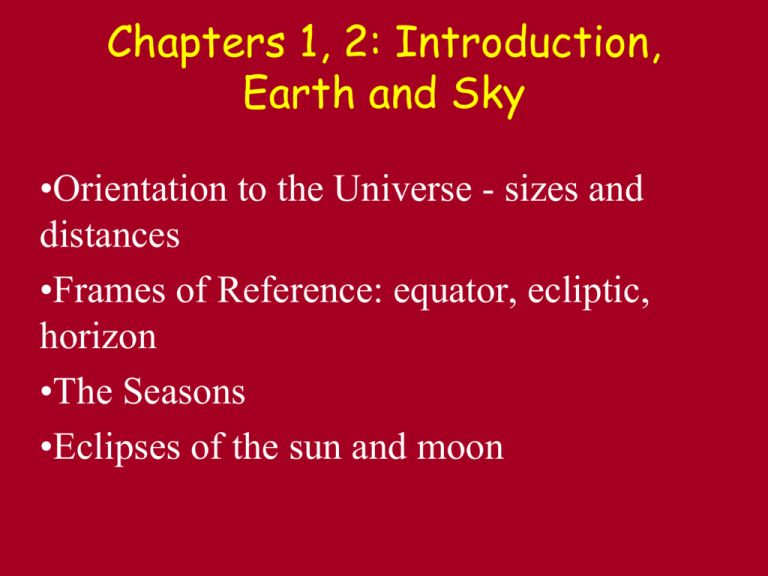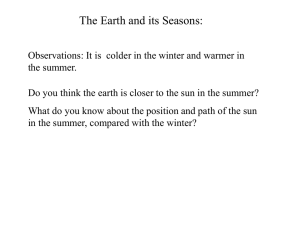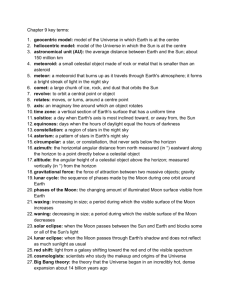Earth and Sky, Seasons, Eclipses
advertisement

Chapters 1, 2: Introduction, Earth and Sky •Orientation to the Universe - sizes and distances •Frames of Reference: equator, ecliptic, horizon •The Seasons •Eclipses of the sun and moon Dimensions, Units • Distance often given terms of light travel time @ speed of light = 300,000 km/sec • Moon is 2 light seconds away • Sun is 8 light minutes away • Solar system is ~1 light day across • Nearest star is 4 light years away • Milky Way Galaxy is ~100,000 light years across • Andromeda Galaxy – nearest galaxy like our own – is 2 million light years away • The “observable universe” is 14 BILLION light years radius And What is Most of what we see made of…? • Hydrogen! = 1 proton and one electron zipping around it. The simplest atom • 90% of all atoms in the universe are hydrogen atoms • Don’t be fooled… You, me, this room… all are very Untypical in their chemical composition. The 4 Forces Governing the Universe • All (almost all?) natural processes can be described by just 4 fundamental forces of nature… in order from strongest to weakest: • Two Short Range (Nuclear) forces: • 1. The Strong Force – (acts between baryons: [protons, neutrons, pions…]) • 2. The Weak Force – acts between certain elementary particles • And Two Long Range Forces: • 3. Electromagnetism (acts between charges) • 4. Gravity (acts between masses) Back to Earth… let’s get started • How does the sky behave, and why? • What causes the seasons? • The earth and it’s motions and how this affects the sky Did all the Ancients figure the Earth was Flat? • Might seem so, but the ancient Greeks figured out it was a sphere. How? By watching eclipses of the moon and noting they always happened 180 degrees away from the sun. • They even measured how big it was, correctly! Way back in ~600BC. Erotosthenes did this. StarTrailsKilamanjaro The Seasons •Primary cause – Earth’s rotation axis is tilted relative to orbital axis •Warmer in summer because (1) more hours of daylight, and (2) daytime sun is higher in the sky •Earth’s orbit is nearly a circle: 92 million miles at closest, 94 million at farthest – conclusion: not much, and so doesn’t affect seasonal temperatures much Axis vs orbit tilt Solstices and Equinoxes • Equinox – “Equal periods of Night”. Everywhere gets 12 hours of daylight, 12 hours of night. • Solstice - “sun stands still”. The sun has reached farthest north or south of the celestial equator, and reverses direction. • Winter Solstice: Dec 21. Sun is farthest south, 23 degrees south of the celestial equator • Spring Equinox: Mar 21. Sun crosses the celestial equator heading north • Summer Solstice: June 21. Sun is farthest north, 23 deg north of the celestial equator • Fall Equinox: Sept 21. Sun crosses the equator heading south. Seasons diagram Precession Axis Tilt, not Distance to Sun, Causes Seasonal Temperature Differences • Common misconception – sun is “farther” in winter, “closer” in summer. Nope! • Earth’s orbit IS elliptical and distance to the sun does vary, but not by much; 91.9 million miles vs 94 million miles. • How much would you expect this would affect temperatures? Interesting Facts: • We’re closest to the sun on January 4th • We’re farthest from the sun on July 4th (plus or minus a day or two because of leap year) Eclipses of the Sun and Moon • Eclipses happen when earth’s shadow follows on the moon (Lunar Eclipse), or moon’s shadow falls on the earth (Solar Eclipse). • How would this affect when/if eclipses happen? Solar eclipse types SanDiegoAnnular Solar eclipse sequence SolarTotalityfromSpace AntarcEclSpace Ecliptic and Total Lunar Eclipse in Leo Total lunar eclipse from the moon lunarEclUmbraPenumbra Lunar eclipse types Penumbral eclipse sequence CompleteLunarEcl totality3lunareclipse totalEclipseZubenalgenubi This semester, we don’t have time to cover the phases of the moon. • But if you’re interested anyway, check out the next few slides… http://aa.usno.navy.mil/graphics/Mo on_movie.gif Phases of the Moon These 3 quantities are related. Given any two, you should be able to determine the third 1. The phase of the moon 2. The time of day 3. The place of the moon in the sky This is one of my favorite quiz questions! How do the Moon’s phases look, from high above the Earth/Moon system, compared to here on the ground? • This link tells all! Very nice. This Photo is a Tease! We’ll Discuss in Chapter 4 Key Points • The most abundant element in Universe: Hydrogen • Know how the sky turns if you are on the Earth’s equator, midlatitudes, and poles. • Know the seasons and where the sun is during each of them. • Earth’s orbit is elliptical, closest to sun Jan 4, farthest on July 4, but only different by 2% • Know why summers warmer than winters • Lunar eclipses: moon passes into Earth’s shadow, always at Full moon phase • Solar eclipse: moon’s shadow cast onto Earth, always at New Moon phase.






